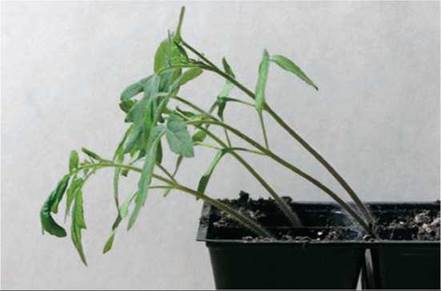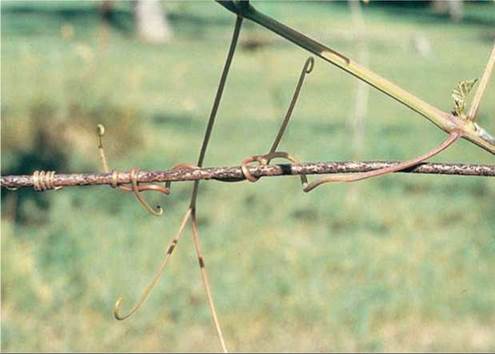CONCEPTS IN BIOLOGY
PART V. THE ORIGIN AND CLASSIFICATION OF LIFE
22. The Plants Kingdom
22.10. Plant Responses to Their Environment
Our casual impression of plants is that they are unchanging objects. However, on closer examination we recognize that plants change over time. They grow, produce flowers and fruits at certain times of the year, and grow toward a source of light. Furthermore, they respond to organisms that harm them and may even mount an attack against competitors.
Tropisms
A tropism is a growth movement toward or away from a stimulus. For example, plants orient themselves toward light.
This is known as phototropism. The value of this response is obvious, because plants need light to survive. The mechanism that allows this response involves a hormone known as auxin. The growing tip of the stem produces auxin, which is transported down the stem. Auxin stimulates cells to divide, grow, and elongate. If the growing tip of a plant receives more light on one side, the shaded side produces more auxin than does the lighted side. The larger amount of auxin on the shaded side causes greater growth in that area, and the tip of the stem bends toward the light. When all the sides of the stem are equally illuminated, the stem grows equally on all sides and grows straight. House plants near a window must be turned regularly, or they will grow more on one side than the other (figure 22.26).

FIGURE 22.26. Phototropism
These tomato plants were growing in a window and have oriented themselves to the light coming through the window.
Many kinds of climbing vines are able to wrap stringlike tendrils around sturdy objects in a matter of minutes. This kind of growth response is called thigmotropism. As the tendrils grow, they slowly wave about. When they encounter an object, their tropic response is to wrap around it and anchor the vine. Once attached, the tendrils change into hard structures that bind the vine to its attachment. Sweet peas, grapevines, and ivy attach in this manner (figure 22.27). Ivy can cause great damage to buildings as it grows, and its tendrils loosen siding and serve as a haven for the growth of other destructive organisms.
Plants also have growth responses to gravity and the presence of water. Stems grow up; roots grow down and toward water in the soil.

FIGURE 22.27. Thigmotropism—Clinging Stems
Some stems are modified to wrap themselves around objects and give support. The tendrils of this grapevine are a good example.
Seasonal Responses
Plants live in a seasonal world, and they respond accordingly. Plants that live in temperate regions experience changes in temperature and the amount of sunlight. The days are longest in the summer and shortest in the winter. Plants are able to measure day length and manufacture hormones that cause changes in the growth and development of specific parts of the plant. Some plants produce flowers only when the days are getting longer, some only when the days are getting shorter, and some only after the days have reached a specific length. In deciduous trees, the shortening day length in the fall triggers a response that causes the tree to produce a wall of waterproof tissue between the leaves and the stem. Because the leaves no longer receive water, they die and fall to the ground.
Other plants store food materials in underground structures such as bulbs and tubers during the active growing period in the summer. In the fall the above-ground part of the plant dies back, but the underground portion remains alive in a dormant state. In the spring, as the soil warms, these storage structures send up new growth.
Many parts of the world experience seasonal rainfall. Rain is abundant for several months and totally absent during others. Plants’ responses to these conditions are similar to those of plants that respond to seasonal changes in temperature. During the dry season, the leaves fall from trees and many smaller plants become dormant. When it rains, the plants respond by growing, flowering, and fruiting.
Responses to Injury
Plants are attacked by a variety of disease-causing organisms and by plant-eating herbivores. Plants respond to disease in much the same way as animals do. When infected with a disease organism, they have an innate ability to fight the infection. Plants also repair wounds by growing a form of scar tissue over the wounded area.
Attack by herbivores is handled in a different way. Many plants produce toxic materials, which interfere with the metabolism of animals that eat plants. When the leaves of plants are eaten by animals, the new leaves produced to replace those lost often contain higher amounts of toxic materials than the original leaves.
Plants may even have the ability to communicate with one another. An experiment carried out in a greenhouse produced some interesting results. Some of the plants had their leaves mechanically “eaten” by an experimenter, whereas nearby plants were not harmed. Not only did the cut plants produce new leaves with more toxins, but the new growth on neighboring, nonmutilated plants had increased toxin levels as well. This raises the possibility that plants communicate in some way, perhaps by the release of molecules that cause changes in the receiving plant.
22.10. CONCEPT REVIEW
23. Describe phototropism and thigmotropism.
24. Describe two examples of how plants respond to environmental changes.
25. Why might a plant gain an advantage by producing toxic substances in its tissues?